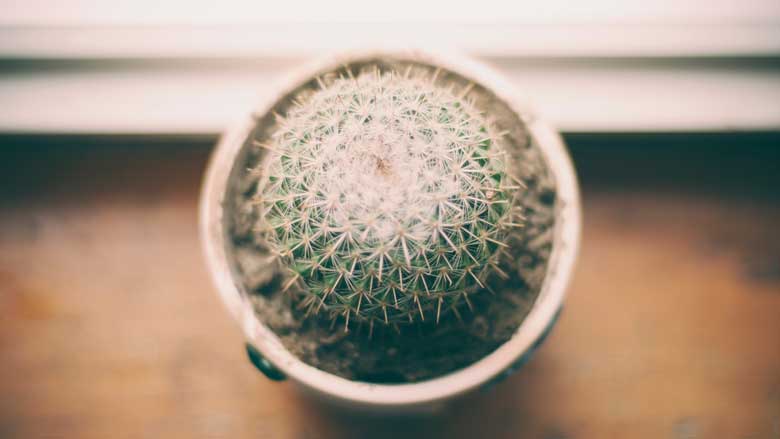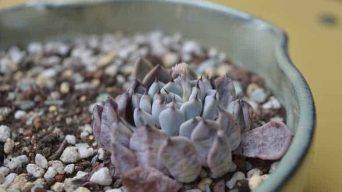Underwatered cacti show signs like light green or yellowish color, easily falling spines, wilting, and weak new growth. To revive, water thoroughly without overwatering, adjust frequency by season, and ensure good soil drainage. Prevent by understanding water needs, checking soil moisture, using the right soil mix, and maintaining a regular watering schedule.
Are your cacti not doing so well? If you think they may be underwatered, learn how to identify and fix the problem.
Cactus plants are known for their ability to survive without water.
However, this is only true if they have been cared for properly until then.
In this article, we will discuss how to identify the symptoms of an underwatered cactus and how to treat them so they can thrive again.
What Are the Risks of Underwatering a Cactus
Both underwatering and overwatering pose significant challenges for indoor plants.
In optimal conditions, a cactus flourishes, producing vibrant blooms that enliven any space.
A cactus suffers from insufficient hydration when it receives water too sporadically or grows in suboptimal conditions.
Though it might not seem critical at first, the impact of insufficient hydration on cacti can be profound and enduring.
The consequences of insufficiently watering a cactus include:
1. Stunted Growth or Complete Failure To Grow
This is because water plays a significant role in photosynthesis.
If your plant isn’t getting enough water, it will not produce chlorophyll and cannot carry out normal processes like converting carbon dioxide and sunlight into glucose.
This is the most severe consequence of insufficiently watered cacti and can be irreversible in many cases.
If your plant’s growth has been stunted due to insufficient water, it may never grow again, even after proper watering practices are resumed.
2. Dehydrated Cactus (Drought Stress)
Underwatering a cactus does not always result in death or permanent damage; when this happens, plants will often lose their green coloration and appear “dull” for a while before finally recovering with fully hydrated roots.
However, the stem, central to the cactus’s ability to transport water and nutrients, may become compromised during dehydration.
Over time, these episodes take a cumulative toll on the plant’s health until there is noticeable lasting damage, which cannot be reversed by additional watering alone.
3. Root Rot
If your cactus is kept in an area with poor air circulation and too much moisture, this can result in root rot.
The cactus’s roots left underwater for too long become infected by various forms of fungi and bacteria.
Like dehydration, these infections are usually fully reversible when you resume proper watering practices.
However, if they have progressed far enough to cause permanent damage, plant health may have lasting effects even after treatment has begun.
4. Root Loss or Death
The most extreme consequence for cacti deprived of water occurs when the roots are completely cut off from any water supply.
If this happens, the roots’ cells will become dehydrated and die; if enough of these cells die, the entire root system (and consequently the plant itself) may rot and eventually fall apart entirely.
This is a very serious condition that can be fatal to cacti – but it’s also completely preventable as long as you don’t allow your plants to dry out too much between waterings.
How Does Underwatering a Cactus Occur?
If you are new to growing cactus plants, it is easy to make mistakes like underwatering.
They require very little water compared to other houseplants and succulents, but there are right and wrong ways of doing things.
The most common mistake people make is to water their cactus too infrequently.
The frequency with which you need to water your cacti depends on where they’re being kept and the type of potting soil mix they have been planted in, but generally speaking, they should be watered once a week at most during warmer months.
During wintertime, when no growing cycles occur, reduce watering until spring comes again.
If you live in areas with high temperatures year-round, these plants can take more frequent showers if needed without causing any damage or stress-related problems because the heat will dissipate much faster than for those living near coasts or other cooler climates.
You should only water your succulents when the soil feels dry.
By this, we mean it won’t take long for a finger inserted into the top couple of centimeters of soil to feel dry enough to warrant watering.
If you wait too much longer than this before giving them a drink, they will become stressed out and more difficult to revive as time goes on if their droopy appearance continues without being watered back up again.
Once you have watered your cactus, wait a few days and check if it needs more water.
If the soil is still moist to touch after this time frame, hold off on watering until next week, when they should be ready for another drink.
How To Tell If Your Cactus Is Underwatered
It may be difficult to tell if your cactus is underwatered.
Underwatering usually occurs gradually, so the cactus will not look drastically different daily.
However, there are a few signs you can look for to determine if your cactus is receiving insufficient water.
Signs of Underwatering
Identifying the signs of insufficient watering in your cactus is crucial for early intervention, enhancing the likelihood of recovery.
Key indicators of insufficient watering include:
1. The Cactus Is Light Green or Yellowish
A cactus lacking sufficient water will shed its vibrant dark green color, transitioning gradually to a lighter green or yellowish tone.
This change often unfolds slowly, making it initially hard to detect.
Should your cactus exhibit such coloration, searching for additional indicators of insufficient watering is advisable.
Among essential care tips, monitoring the plant’s color can provide early warning signs of hydration needs, ensuring your cactus remains healthy.
2. The Spines Are Falling off Easily
A properly watered cactus has roots that reach deep into the soil, efficiently absorbing water.
Conversely, in conditions of insufficient water, the cactus’s roots struggle to function due to a nutrient deficit in the soil, resulting in their deterioration.
This issue results in fragile spines that detach easily, indicating poor hydration.
3. The Cactus Is Wilting
Wilting is a common symptom in cacti receiving insufficient water.
The spines, crucial for support, fail to sustain the plant’s structure because of nutrient shortages, leading to a loss of shape.
Consequently, cacti that previously stood upright and firm may gradually become limp or droopy.
4. Decay at the Base of the Plant
When roots cannot absorb enough nutrients from the soil due to lack of water, they will stop growing and start deteriorating over time, leading to decay at the base of the plant.
This usually happens gradually, so you may not immediately realize if your cacti are underwatered.
5. The Cactus Spines Turn From Black to a Light Brown Color
When a cactus receives insufficient water, its spines shift in color from a dark black or brown to a lighter brown.
This transformation often happens slowly, making it difficult to detect immediately.
To identify a plant that’s not getting enough water, watch for additional indicators, such as the cactus beginning to adopt a light green or yellowish hue.
6. The New Growth on Your Cacti Is Weak and off Center With Older Growth
When a cactus does not have enough nutrients, it will affect how it grows new limbs, resulting in the new growth on your succulent being weak and off-center compared to older growth.
In this case, you’ll notice that newer growth is somewhat malformed and less symmetrical than older ones – another sign of underwatering.
How To Save Underwatered Cacti?
Determining whether your cacti require more water involves examining the soil’s moisture level. This is a crucial part of cactus care.
If the soil feels dry and hard when you squeeze it between your fingers, then it’s likely that its roots are dying back due to a lack of water.
Once you’ve identified that your cactus needs more water, make sure to follow these steps:
1. Water Thoroughly, but Do Not Overwater
It might be tempting to give them a lot of water all at once because they look in dire need.
However, overwatering cacti can lead to root rot if you overdo it – something that’s almost impossible for the plant to recover from.
2. Water Them Every Two Weeks During the Winter and Once a Week in Summer
Watering frequency depends on how hot it is where you are located – hotter climates require more frequent watering than cooler ones.
For example, if your cactus gets three hours of sunlight or less per day, water around one to two times a month throughout the year.
However, if they receive six hours of sun exposure daily, then aim for twice-weekly watering until fall when temperatures cool down again.
3. Use Soil That Drains Well So Excess Water Can Seep Out Freely
Water thoroughly and allow water to drain out freely.
Cacti tend to do best with fast-draining soil, allowing excess water to flow through quickly so they can absorb it as needed.
Many commercial cactus soil mixes are available for this very purpose these days – look for one with sand or perlite added to the potting mix.
This will help improve the drainage of your cactus roots, which also helps prevent root rot from forming when you overwater them.
4. Use a Pot With at Least One Bottom Drainage Hole
When planting in containers, it’s essential to use a pot with at least one bottom drainage hole.
This ensures that any excess water can seep out easily without getting trapped inside, where it could potentially cause root rot.
This advice is particularly crucial if you’re using clay pots, which often come without holes in the bottom.
Ensuring your pot has proper drainage supports healthy plant growth by preventing water from accumulating and harming the plant’s roots.
5. Water Deeply but Do Not Water Frequently
Watering frequency will depend entirely on how much sunlight your cactus gets daily.
If they get at least three hours of direct sun exposure, water once every two weeks during winter and once a week throughout spring/summer when temperatures rise again to prevent wilting.
However, if they’re getting less than that (or none), try watering around once or twice monthly, depending on their size.
Smaller plants can be watered slightly more often, while larger ones need less frequent watering until fall comes again.
6. Repot the Plant in Fresh Soil if Necessary
A cactus with insufficient watering might require repotting into fresh soil, especially if its roots have significantly receded.
This action encourages new growth, enhancing the plant’s overall health. Indicators of insufficient water include stunted or malformed new shoots.
Repotting can also enhance drainage, facilitating the easier expulsion of any excess water absorbed by the plant.
Prevention Strategies
Preventing underwatering in cacti is crucial for maintaining their health and vitality.
Here are some strategies to ensure your cacti receive the right amount of water and thrive in their environment:
- Understand Your Cactus’s Water Needs: Different cactus species have varying water requirements. Research your specific type of cactus to understand how much water it needs and adjust your watering schedule accordingly.
- Monitor the Environment: The amount of sunlight, temperature, and humidity can all affect how quickly a cactus uses water. Cacti in hotter, sunnier, or drier conditions may need water more frequently. Adjust your watering frequency based on seasonal changes and environmental conditions.
- Check the Soil Moisture: Always check the soil’s moisture level before watering your cactus. Use a moisture meter or insert your finger into the soil until the second knuckles. If the soil feels dry, it’s time to water. This method helps prevent both underwatering and overwatering.
- Use the Right Soil Mix: Plant your cactus in a soil mix that promotes good drainage. A mixture of potting soil, coarse sand, and perlite or pumice is ideal for most cactus types. This ensures that water reaches the roots but doesn’t accumulate, reducing the risk of root rot.
- Select the Correct Pot Size and Material: Use pots that are appropriately sized for your cactus and have drainage holes. Terracotta pots are excellent for cacti because they’re porous and allow soil to dry more evenly.
- Establish a Regular Watering Schedule: While being mindful of the cactus’s needs and environmental conditions, try to establish a regular watering schedule. Keep track of when you water and adjust based on the plant’s response and seasonal changes.
- Educate Yourself on Signs of Underwatering: Familiarize yourself with the signs of an underwater plant discussed earlier. Early detection and correction can prevent long-term damage to your cactus.
- Use Rainwater or Distilled Water When Possible: Tap water can contain minerals that might build up in the soil and potentially harm your cactus. If possible, use rainwater or distilled water to avoid these issues.
Implementing these prevention measures can greatly decrease the likelihood of providing insufficient water to your cactus.
Regular observation and adjustment of your care routine ensure your cactus stays healthy and vibrant.
Final Thoughts
A cactus not receiving sufficient water may suffer due to several reasons, particularly when its outdoor environment or even an indoor setting like a kitchen, including factors like soil type, pot size, and proximity to a wall, is not adequately considered.
Often, it arises from the misconception that these plants require minimal hydration, leading to insufficient watering practices.
It’s crucial to find the right balance when hydrating a cactus. Overwatering can result in rot, while inadequate watering may lead to irreparable root damage.
Therefore, recognizing the indicators of insufficient hydration in cacti is vital for their health and longevity.
Proper care and attention to these details are essential in ensuring the thriving of these resilient yet sensitive plants.







